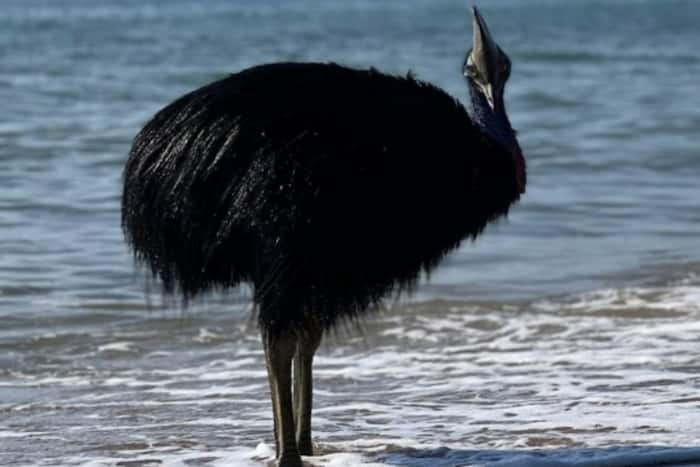When that being appeared, it was clear that it was something else, perhaps not from this earth.
The world’s most dangerous bird: When you think or talk about dangerous birds in the world, it usually concerns eagles, hawks and falcons. These are excellent hunters and their hunting skills are legendary. However, it seems that apart from the dangerous birds we know of, there is one we missed that was spotted in Australia on Tuesday, October 31, 2023, Halloween Day, when beachgoers at Bingil Bay on the east coast of Australia abandoned. They were shocked to see a menacing, dark shape splashing around in the water.
They suspected it was a shark, a turtle or some other sea creature. But when that being appeared it was clear that it was something else, perhaps not from this earth. Upon closer inspection, it turned out to be a young cassowary, commonly known as the “world’s most dangerous bird.”
The cassowary sighting was immediately reported to the Queensland Department of Environment and Science and since that day the “world’s most dangerous bird” has gone viral.
Who are Cassowaries?
Cassowaries are flightless birds native to the tropical forests of New Guinea (Papua New Guinea and West Papua), the Aru Islands (Maluku) and northeastern Australia. Three species of cassowary have been preserved. The most common, the southern cassowary, is the third tallest and second heaviest living bird, smaller only than the ostrich and emu.
They are known for their prehistoric appearance, height, strong legs and clawed feet, with the potential to cause serious damage. The flightless birds are quite wary of humans and are unlikely to attack unless provoked.
The sighting of a southern cassowary in the water comes as a surprise, as many people do not realize that cassowaries can swim. “Cassowaries can swim and take to the water to cross from one side of a river to the other, or if they feel threatened by domesticated dogs or another cassowary due to a territorial dispute,” said Stephen Clough, a conservationist at the Queensland Parks. and Wildlife Service (QPWS) in a press release.
“We’re not sure how long this animal was in the water or why it started swimming, but the footage is astonishing.”
How far did the world’s most dangerous bird swim in the water?
The cassowary swam about 200 yards offshore, said Bingil Bay Campground host Nikita McDowell.
“I ran down and waited for the cassowary to emerge from the ocean, and he must have been exhausted standing in the shade under a tree for about half an hour with his legs shaking,” McDowell said.
“It may have entered the ocean around south of Mission Beach and was caught by the current or in a rip and swept towards Bingil Bay,” she added.
Bingil Bay and Cassowary Coast
Bingil Bay is often referred to as the ‘Cassowary Coast’. The traditional owners of the land call the area Djiru Country and call the cassowary the goondoi. The bird is an important species to First Nations people in Australia and plays a key role in reproducing rainforest trees, some of which will not germinate until they have passed through the large herbivore’s digestive system.
Endangered bird
There are only an estimated 4,000 cassowaries left in Queensland, and their population is listed as endangered under the Nature Conservation Act 1992.
These beautiful birds are threatened by vehicle attacks, dog attacks and visitors to the area. Visitors are advised never to approach the birds and to give them enough space. “This rare sighting and lucky escape by the cassowary reminds us that we must all do what we can to protect and conserve the species,” Clough said.
How dangerous are cassowaries?
Besides ostriches, they are one of only two bird species known to have caused human death from physical attacks. A review on cassowary attacks published in 2006 in the Journal of Zoology looked at 221 observed cassowary attacks, 150 of which were against humans.
As many as 75 percent of these attacks were the result of humans feeding the birds (which they are advised not to do). The birds attacked just over 70 percent of the time, and used their talons in 15 percent of the attacks.
If you ever come face to face with one of these beautiful birds, don’t forget to approach it or try to feed it. Especially if there are eggs or chicks nearby.
Back away slowly and try to place a backpack or other object between you and the bird, the Ministry of Environment and Science advises.
Diving into the sea is a bad idea to escape because they can swim.


